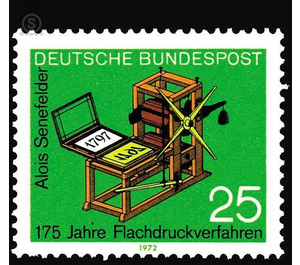175 years Flat printing process - Germany / Federal Republic of Germany 1972 - 25 Pfennig
Theme: Devices, Items & Instruments
| Country | Germany / Federal Republic of Germany |
| Issue Date | 1972 |
| Face Value | 25.00 |
| Color | green |
| Perforation | K 13 1/2: 13 |
| Printing Type | Multicolor offset printing |
| Stamp Type | Postage stamp |
| Item Type | Stamp |
| Chronological Issue Number | 604 |
| Chronological Chapter | GER-BRD |
| SID | 339516 |
| In 46 Wishlists | |
Alois Senefelder, who was born on November 6, 1771 in Prague and grew up in Munich, invented in 1796 the chemical lithography, the planographic printing. As the son of an actor, he wanted to follow in the footsteps of his father, but at his request, he studied in Ingolstadt the rights. Incidentally, he worked as a lay actor and wrote several plays. Since he had no money, he wanted to print his own pieces. He first tried engraved letters in steel and hit the die in pear wood. In addition, he wrote with a steel spring on a copper plate letters reversed. However, these experiments did not produce the desired result. He then proceeded to use a more docile stone instead of the hard metal plate and etch the writing. In 1796 he made his breakthrough. Using feather, brush and special ink, with black or red chalk, Senefelder wrote and drew on a smooth stone worked with gum arabic solution and nitric acid. The strokes took the ink; the rest of the surface repelled the paint according to the principle of contrasting fat and water. To high pressure and gravure now joined the planographic printing. Senefelder managed the transition from mechanical to chemical planographic printing in 1797. Senefelder, who lived in very poor economic conditions, received the decisive help from outside in 1799. The music publisher and music dealer Johann Anton André from Offenbach am Main, who had acquired Mozart's estate, had Senefelder come to Offenbach, where he set up a lithographic printing works. For the first time Senefelder's invention was used economically. With the help of his brothers Philipp and Friedrich, Johann Anton André introduced lithography to London and Paris. From Offenbach lithography made its way into the world. André and Senefelder were granted patents both in England and in France. Senefelder's stay in London led to encounters with well-known artists who were interested in his invention. Thus, between 1801 and 1803, the first and excellent artist lithographs were created. Soon a number of well-known artists in Germany and France used this new method. The ingenious sculptor and draftsman Gottfried Schadow most aptly characterized the importance of lithography: "In the lithographic proofs, the first, original spirit of the draftsman remains, and the transference or translation by another falls away." Senefelder was technically gifted. So he constructed the first bar press in 1799, improved the star press and later invented a handy pressure box. Among the more than 20 models he built was a litho-printing machine that did the inking of the colors themselves. The transition from the manual press to the machine press was initiated by Senefelder himself. After his stays in Offenbach, London and Vienna, Senefelder returned in 1806 to his adopted home of Munich. In 1809 he published a "sample book" containing a catalog of the previously developed lithographic techniques. In 1816 Senefelder wrote at the insistence of Johann Anton André his "Complete textbook of lithography", which appeared in 1819 also in French and English. In 1819 Senefelder moved to Paris, where he stayed until 1824. Here he tried instead of the famous Solnhofer stones to make a fabrication of the invented by him "artificial stones", which, however, was associated with difficulties. The "artificial stones" were slightly fragile. In March 1834, Sensfelder, honored with many honors and medals, died in Munich. His revolutionary invention, lithography, was the starting point for offset printing, which is increasingly gaining a dominant position in the printing industry.


